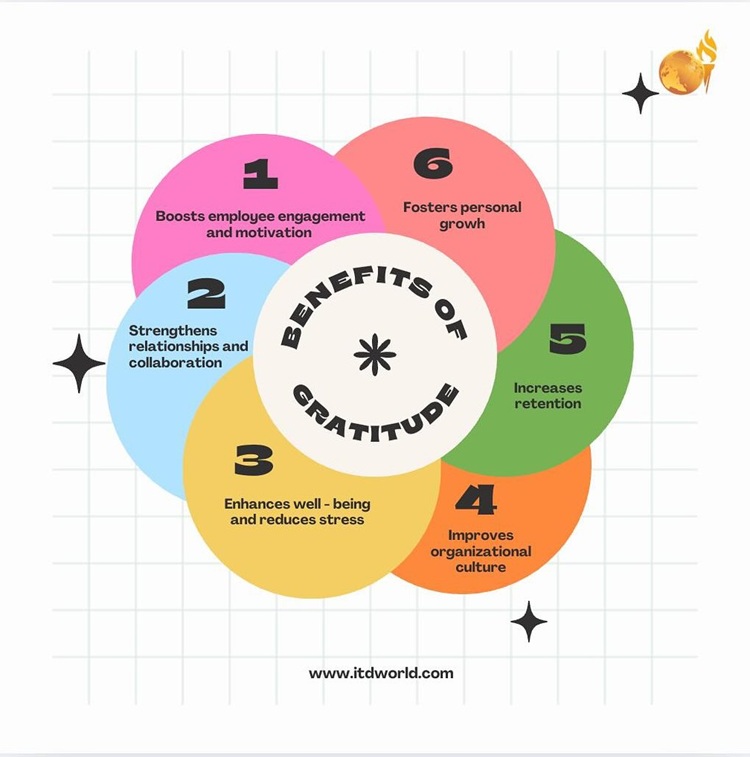Discover the power of showing gratitude in the workplace, plus how to practice giving thanks to others for long-term success.
Cultivating and expressing gratitude in the workplace is not merely a courtesy; it’s a fundamental gesture with the power to profoundly influence individual well-being, team effectiveness, and overall organizational success. Despite its proven impact, many people – including those in leadership positions – find it challenging to consistently demonstrate authentic appreciation. However, overlooking this critical practice means missing out on the opportunity to establish stronger relationships, foster deeper loyalty, and drive collective achievement.
|
Author: Jonathan M. Pham |
Highlights
- Gratitude in the workplace is a conscious and genuine appreciation for the contributions, support, opportunities, and positive aspects of the work environment; it extends beyond simple politeness to acknowledge the value people and the organization bring.
- Gratitude at work plays a crucial role in boosting employee engagement, strengthening relationships, enhancing well-being, improving organizational culture, increasing retention, and fostering personal growth.
- Despite its known benefits, expressing gratitude is typically challenging due to reasons like feeling awkward, taking contributions for granted, misconceptions about professionalism, fear of obligation, ego, and a simple lack of awareness or mindful pause.
- To effectively cultivate gratitude in the workplace, one should prioritize sincerity, develop awareness of contributions, shift from expectation to appreciation, express thanks in a timely, specific, and personal manner using appropriate mediums, show gratitude through reciprocal actions, and cultivate personal reflection habits like gratitude journaling or daily check-ins.
- Practicing gratitude leadership is a strategic imperative where leaders actively recognize their interdependence with the team, prioritize and integrate appreciation into interactions, lead by example, and demonstrate support through action, significantly shaping a positive and high-performing workplace culture.
- Building a culture of gratitude requires intentional effort from leadership and HR to make appreciation a shared value through formal recognition programs, integrating it into communications and values, creating platforms for sharing thanks, providing training, and linking it to the overall employee experience.
What is Gratitude in the Workplace?
Gratitude, in its broadest sense, is the quality of being thankful; a readiness to show appreciation for and to return kindness. Unlike mere politeness, it is rooted in genuine feeling and an awareness of the positive elements present – an internal state that can then be expressed outwardly.
Applied to a professional environment, gratitude is more than just a simple ‘thank you’ after someone holds a door or passes a document. It represents a deeper, more conscious appreciation for the contributions, efforts, support, opportunities, and interactions that occur everyday.
At its core, it is about:
- Acknowledging value: Recognizing the worth that colleagues, team members, leaders, and even the organizational structure itself bring to your work experience. This includes acknowledging their skills, dedication, unique perspectives, and the impact they have on shared goals.
- Appreciating support and collaboration: Valuing the help received, the willingness of others to collaborate, share knowledge, or lend assistance when needed.
- Recognizing opportunities: Being thankful for the chances to learn, grow, take on new challenges, and contribute to the organization’s mission.
- Fostering a positive outlook: Cultivating a mindset that actively looks for the positive aspects of the work environment, the tasks at hand, and the people involved, even amidst challenges.
Examples of gratitude in the workplace:
- The relief felt when a colleague steps in to help meet a tight deadline.
- The appreciation for a mentor‘s time and insightful guidance that helps navigate a complex issue.
- Acknowledging the organization for providing resources or training that enhances your professional skills.
- Recognizing a team member’s consistent positive attitude that contributes to maintaining morale during stressful periods.
- Welcoming constructive feedback from a manager that, while challenging, is clearly aimed at facilitating your growth.
- Feeling thankful for the chance to work on a project that is personally engaging and aligns with your strengths.
- etc.

Cultivating gratitude in the workplace
Importance of Gratitude in the Workplace: Proven Benefits
Gratitude is not only the greatest of virtues, but the parent of all the others.
Cicero
Gratitude possesses a remarkable power, far exceeding a simple pleasantry. It’s a fundamental human emotion and practice with profound implications for individual well-being, interpersonal relationships, and overall organizational performance. Genuine gratitude creates a positive feedback loop that enhances numerous aspects of the professional experience.
The impact of gratitude in the workplace is not merely anecdotal; it is supported by research demonstrating tangible benefits:

- Boosts employee engagement & motivation
Research consistently shows a strong link between recognition – a key expression of gratitude – and higher levels of employee engagement. A Gallup report, for instance, highlighted that employees who feel recognized and thanked are more productive, remain with the company longer, and are more loyal to their organization.
Feeling genuinely valued provides intrinsic motivation, encouraging individuals to go the extra mile.
- Strengthens relationships & collaboration
A sincere ‘thank you’ acts as a social glue – it builds rapport, fosters trust, and strengthens the bonds between colleagues and managers. According to research discussed in the Harvard Health Blog (referencing studies like those by psychology researchers), expressing gratitude can improve relationships and foster a sense of connection, making people feel closer and more committed to one another.
Stronger relationships facilitate better communication, enhance teamwork, and create a more supportive environment where team members feel comfortable collaborating and sharing ideas.
- Enhances well-being & reduces stress
Practicing gratitude has significant psychological benefits for both the giver and the receiver. For the giver, it shifts the focus from stressors to positives, fostering a more optimistic outlook and increasing feelings of fulfillment. This translates to greater resilience and a more positive experience of the workday.
Studies often cited in psychological literature indicate that regular gratitude practice is correlated with increased happiness and reduced symptoms of depression and anxiety.
The best thing about saying ‘Thank you’ is that it creates closure in any potentially explosive discussion.
- Improves organizational culture
A workplace where gratitude is regularly expressed and genuinely felt is fundamentally more respectful. It establishes a norm of recognizing and valuing people’s contributions, which boosts morale and creates a more appreciative atmosphere. This cultivates a sense of belonging and mutual respect, counteracting negativity and fostering a more pleasant and productive environment for everyone.
- Increases retention
In a competitive talent landscape, feeling undervalued is a significant driver of employee turnover. Conversely, those who feel recognized and appreciated are more likely to feel loyal to their organization and less likely to seek opportunities elsewhere.
Reports from organizations like the SHRM frequently highlight recognition, often tied to gratitude, as a key factor in employee retention and job satisfaction.
- Fosters personal growth
Expressing gratitude requires humility and an acknowledgment of dependence on others’ contributions and support. This perspective encourages people to be more open to learning from others, recognizing their own areas for development, and embracing a coachable mindset. By appreciating the value others bring, one is better equipped to gain new insights and facilitate their own professional growth.
TED Talk: The power of gratitude
The Role of Gratitude Leadership
The benefits of gratitude are amplified significantly when embraced and actively demonstrated by those in management positions. The important thing is not just about leaders saying thank you; it’s about leaders intentionally cultivating an appreciative mindset and cultivating an environment where gratitude flows authentically throughout the team and organization.
When leaders prioritize and model thanksgiving, it sets a powerful example, making team members feel valued from the top down. Such behavior directly impacts team morale, psychological safety, and trust. Those who express gratitude for their team’s efforts and contributions are more likely to inspire loyalty, increase engagement, and build high-performing teams. Their authentic appreciation reinforces positive behaviors and motivates employees to remain committed to their shared goals, creating a win-win scenario for both the leader and the team.
Challenges of Expressing Gratitude in the Workplace
Gratitude is not a limited resource, nor is it costly. It is abundant as air. We breathe it in but forget to exhale.
Dr. Marshall Goldsmith
Given the significant benefits we’ve discussed above, it might seem counterintuitive that many still find it challenging to give thanks authentically. Common reasons why individuals may be reluctant or find it difficult to express gratitude at work include:
- Feeling awkward or uncomfortable
For some, expressing genuine emotion in a professional setting feels unfamiliar or even vulnerable. There might be a fear of the expression being misinterpreted, appearing insincere, or creating an awkward dynamic, especially if it’s not a common practice within the team or organization.
- Taking contributions for granted
In the routine of daily tasks and projects, it’s easy to overlook or minimize the consistent efforts and contributions of colleagues, subordinates, or even superiors. When specific roles and responsibilities are seen merely as “just doing their job,” the underlying effort, skill, and dedication that facilitate success are likely to be taken for granted, diminishing the impulse to express thanks. This is particularly prevalent when individuals, like managers, are focused on outcomes and deadlines.
- Misconceptions about professionalism
Some people mistakenly believe that expressing gratitude, particularly in a heartfelt manner, might be perceived as unprofessional, overly emotional, or even a sign of weakness. They may feel it’s necessary to maintain a “straight face” or a purely task-focused demeanor, believing that acknowledging dependence on others or highlighting positive emotions is inappropriate in a formal setting.
- Fear of perceived obligation or expectation
Expressing thanks is sometimes associated with creating a perceived “debt” or obligation. Individuals might worry that thanking someone for help could lead that person to expect future favors or that it sets a precedent they cannot always meet.
There might also be a subtle fear of acknowledging that you needed help, which some might view as a personal failing rather than a collaborative success.
- Influence of ego or pride
While not the sole factor, ego does play a significant role. An inflated sense of self or a need to maintain an image of complete self-sufficiency makes it difficult to acknowledge the contributions of others.
Expressing gratitude inherently involves recognizing that someone else’s actions benefited you or the team, which may be challenging for those whose pride makes it hard to admit reliance or share the spotlight. This can manifest as a reluctance to offer praise or thanks where it is due.
- Lack of awareness or mindset
In a fast-paced or results-oriented environment, many people may simply not pause to consciously recognize the moments where gratitude is warranted. The focus remains solely on the next task, deadline, or problem, without taking a moment to reflect on the support received or the positive interactions experienced.
Read more: 7 Leadership Mistakes to Avoid – From Failure to Success
Guide to Practicing Gratitude in the Workplace
Keys to cultivating gratitude at work
- Prioritize sincerity & intent
The foundation of workplace gratitude is genuine appreciation. Before expressing thanks, take a moment to connect with why you are grateful. Is it for a specific action, a consistent quality, or the support received?
Authenticity is key to building trust and rapport. Hence, make sure that your motive is truly to acknowledge the other person’s contribution and value, rather than to simply fulfill a social expectation or gain favor.
Read more: Intent vs Impact in the Workplace – How to Close the Gap
- Develop awareness
In a busy work environment, it’s easy to overlook the myriad contributions of others and the positive aspects of your professional experience. For this reason, it is recommended that you intentionally practice observing the actions, efforts, and support from colleagues, managers, and even cross-functional teams. Try to look beyond the obvious major achievements to notice smaller acts of kindness, helpfulness, or positive contributions that smooth the way or brighten the day.
- Shift from expectation to appreciation
Stop taking things for granted. While people are performing their roles, their specific efforts, the extra mile they might go, or their willingness to collaborate are worthy of specific acknowledgment and appreciation, not just expected outcomes.
How to show appreciation effectively & professionally
- Be timely & specific
Expressing gratitude promptly after an action or contribution occurs is most impactful. It shows you noticed in the moment and value the immediacy of their effort. If there is a delay, try to provide context to ensure sincerity comes through.
Less effective: “Hey, thanks for helping me out with that project… a while ago.” (Vague, delayed, lacks specific connection)
More effective: “Hi [Colleague’s Name], I wanted to circle back and express my sincere thanks for your assistance with [specific task or project] a few weeks ago. Your insights on [mention specific insight or action] were incredibly valuable and genuinely helped us achieve [mention positive outcome]. I really appreciate you taking the time to jump in.” (Timely acknowledgement of a past event, specific, connects action to impact).
- Choose the right medium
Consider the context of your relationship and the nature of the contribution when deciding how to express thanks.
-
- Verbal: Immediate, personal, allows for conveying emotion through tone and body language. Ideal for in-the-moment recognition or private one-on-one appreciation.
- Written (email, messaging app): Provides a lasting record that the recipient can revisit. Useful for formal acknowledgments, summarizing specific contributions, or when a verbal moment isn’t feasible. Professional emails are suitable for managers or more formal relationships; team chat can work for peer-to-peer quick thanks.
- Handwritten note: Offers a highly personal and impactful touch in an increasingly digital world. Best suited for significant contributions, milestones, or when you want to convey a particularly deep level of appreciation.
- Make it personal & specific
Generic thank yous feel hollow. Hence, try to reference the specific action, behavior, or quality you appreciate. Explain why it mattered or what impact it had. Using the person’s name in verbal or written communication adds a personal touch.
Example snippet for written note: “Dear [Name], I wanted to express my heartfelt gratitude for your help with [specific project or task]. Your work on [mention specific action, e.g., the data analysis, the presentation design, troubleshooting that issue] was crucial, and I particularly appreciated [mention a specific quality, e.g., your attention to detail, your willingness to stay late, your creative solution]. It significantly helped us to [mention positive outcome]. Thank you again for your valuable contribution.”
- Show gratitude through action
Gratitude doesn’t always require words. Demonstrating your appreciation through reciprocal actions is a powerful way to show you value someone’s contribution. This could involve offering your help on their project, sharing a useful resource, publicly acknowledging their work to others (with their permission), or simply being supportive and available when they need assistance in the future.

How to show gratitude in the workplace
Developing a personal gratitude practice
- The Gratitude Reflection Exercise: As highlighted by executive coach Marshall Goldsmith, reflecting on those who have contributed to your professional journey is a powerful exercise. Take time to identify those who have significantly impacted your career growth or success. Reflect on their specific contributions and whether you have genuinely conveyed your appreciation – and you should be motivated to reach out and express that previously unarticulated gratitude, reinforcing the interconnectedness of your achievements.
- Daily or weekly check-ins: Dedicate a few minutes each day or week to think about positive occurrences at work. Either mentally note three things you are grateful for (e.g., a helpful colleague, a learning opportunity, a challenging task completed) or jot them down briefly. This practice trains your brain to actively look for positives, making you more aware of opportunities for expressing gratitude outwardly.
- Seek opportunities to acknowledge others: Make it a conscious goal to express gratitude to at least one person each day or week. This helps build the habit and reduces the likelihood of taking contributions for granted.
Read more: Love Leadership – More Than an Abstract Philosophical Idea
Practicing Gratitude Leadership
As mentioned, leaders play a disproportionately powerful role in shaping the workplace environment. Their behaviours and communication set the tone, and it is especially true when it comes to gratitude. Practicing gratitude as a leader isn’t just about personal disposition; it’s a strategic imperative that directly influences team dynamics, performance, and loyalty.
- Recognizing the interdependence
Effective leaders understand that their success is intrinsically linked to the efforts and capabilities of their team. They move beyond viewing employee contributions as mere deliverables and instead actively appreciate the skill, dedication, and problem-solving required to achieve them.
- Making appreciation a priority
In a results-driven environment, leaders are likely to become consumed by metrics and deadlines, overlooking the human effort behind them. As such, it is recommended that they intentionally schedule or set aside moments to observe and acknowledge positive contributions, making appreciation a priority rather than an afterthought.
Integrating gratitude into formal or informal performance conversations elevates its significance. Leaders can acknowledge specific instances where an employee’s skills or efforts contributed positively, linking past contributions to future growth opportunities and reinforcing desired behaviours.
Leaders who embody gratitude create psychological safety for others to do the same. Authentically expressing their own appreciation models the desired behaviour and signals that thanksgiving is valued and expected within the team.
- Demonstrating through support
Beyond words, leaders should do their best to invest in their team’s success and well-being – by advocating for resources, removing roadblocks, providing opportunities for growth, defending the team when necessary, and showing empathy during challenging times.
Read more: 12 Golden Leadership Principles for Attaining Excellence
How to Develop a Culture of Gratitude in the Workplace
While individual acts are foundational, the true transformative power of gratitude is unleashed when it becomes an embedded element of the workplace culture. Developing a culture of gratitude means creating an environment where expressing and receiving appreciation is a shared value, a common practice, and a natural part of the employee experience, supported by organizational systems and leadership commitment. This isn’t something that happens by accident; it requires intentional strategy and consistent effort from the top down and throughout the organization, often spearheaded by Human Resources and senior leadership.
- Formalizing recognition programs
- Peer-to-peer recognition platforms: Digital tools that allow team members to easily acknowledge and thank colleagues for specific contributions, making gratitude visible across teams.
- Nomination-based awards: Systems where employees or managers can nominate individuals or teams for living organizational values or making significant impacts, with appreciation as a core component of the nomination criteria.
- Service & milestone recognition: Programs that acknowledge tenure or project completion, framed not just as duration but with specific emphasis on contributions and the collective journey, incorporating appreciation from leaders and peers.
- Integrating gratitude into organizational values & communications
- Explicitly state gratitude as a value: Include appreciation or gratitude in the company’s stated values or mission statement.
- Leadership communication: Senior leaders should regularly reference and champion gratitude in company-wide meetings, internal newsletters, and communications, highlighting its importance to organizational success and well-being.
- Internal storytelling: Share stories of employees demonstrating gratitude or instances where appreciation made a significant difference, reinforcing desired behaviors.
- Creating dedicated platforms & rituals for sharing
- Company-wide appreciation channels: Utilize internal communication platforms (like Slack, Teams, intranet forums) for dedicated “shout-out” or “gratitude” channels where anyone can publicly thank another employee or team.
- Team meeting rituals: Encourage or mandate a standing agenda item in team meetings for team members to share appreciation for colleagues’ help or contributions since the last meeting.
- Gratitude boards/ walls: Implement physical or virtual boards or walls where employees can post thank-you notes or messages of appreciation.
- Providing training & resources
Equip employees and managers with the understanding and skills needed to give thanks effectively and overcome the challenges discussed previously.
-
- Workshops: HR may facilitate training sessions on the power of gratitude, how to give and receive feedback (including appreciation), and specific techniques for expressing sincere thanks.
- Manager training: Specifically train leaders on their role in fostering gratitude within their teams and utilizing recognition tools.
- Resources: Provide guides, tips, or digital resources on expressing specific and timely appreciation.
- Linking gratitude to employee experience & feedback
- Employee surveys: Include questions about feeling valued, recognized, and comfortable expressing appreciation in employee engagement or pulse surveys.
- Exit interviews: Gather insights from departing employees on the recognition culture.
- Incorporate into performance management: Ensure managers are encouraged or expected to provide specific, appreciative feedback as part of ongoing performance conversations, not just critical one.

Gratitude in business: Idea & activities
Read more: Soliciting Feedback – Key to a Building a Better Workplace
Gratitude in the Workplace Quotes
Check out more quotes about gratitude here!
Gratitude is the healthiest of all human emotions. The more you express gratitude for what you have, the more likely you will have even more to express gratitude for.
Zig Ziglar
Thankfulness is the beginning of gratitude. Gratitude is the completion of thankfulness. Thankfulness may consist merely of words. Gratitude is shown in acts.
Henri Frederic Amiel
The roots of all goodness lie in the soil of appreciation for goodness.
Dalai Lama
As we express our gratitude, we must never forget that the highest appreciation is not to utter words, but to live by them.
John F. Kennedy
Feeling gratitude and not expressing it is like wrapping a present and not giving it.
William Arthur Ward
Be grateful for little things every day and notice how your life changes as you marvel at bigger things that come your way.
Dr. Marshall Goldsmith and Dr. Peter Chee, ‘Mother of all Virtues‘
Final Thoughts
The simple act of showing gratitude in the workplace is often underestimated – yet it holds significant power in transforming team dynamics and paves the way for sustainable growth. When gratitude becomes ingrained in the organizational fabric, it cultivates an environment where innovation flourishes, collaboration thrives, and productivity soars. As leaders, learning to say “thank you” is not only basic manners; in fact, it is a vital catalyst for excellence and fulfillment.
Other resources you might be interested in:
- Finding Happiness in Your Career: A How-to Guide
- Fish Philosophy: Creating a Joyful & Productive Workplace
- Inspirational Leadership: Key Principles & Practices
- Why Follow Up Matters in Behavior Change & Leadership
- The Power of Apology: How to Say Sorry as a Leader

